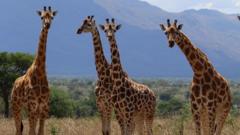Giraffes, known for their towering heights and unique appearances, have often been classified under one species, but recent findings by the International Union for Conservation of Nature (IUCN) have unveiled that there are indeed four distinct species. This revelation marks a significant development in the understanding of these majestic mammals, long considered a singular group.
Scientists reached this conclusion through an extensive study comparing skull sizes and head shapes, revealing enough genetic diversity to warrant separate classifications. The researchers focused on Africa's natural barriers, such as mountains and rivers, which historically may have led to evolutionary divergence among giraffe populations.
The first newly-recognized species is the Southern giraffe, which inhabits Angola, Botswana, Namibia, Zimbabwe, Zambia, and Mozambique. It is believed that the Kunene and Zambezi rivers and the Congo Basin's rainforest contributed to the separation from other giraffe populations.
Next is the Reticulated giraffe, found primarily in the savannas and wooded grasslands of Kenya, Somalia, and Ethiopia. The Tana River and Ethiopia’s mountainous terrain likely kept this species isolated from others. Being a migratory species, it may have had opportunities for cross-breeding in the past.
The Northern giraffe, the third species, resides in Ethiopia, Kenya, South Sudan, and Uganda. Its migration patterns and geographic features such as the Nile River and Lake Victoria are effective barriers that separate it from others.
Finally, the Masai giraffe, known for its striking leaf-pattern coat, lives in Kenya, Tanzania, and Uganda. Although distinct in appearance, experts note that variations in patterns exist even within individual populations, complicating species identification.
The IUCN emphasizes that recognizing these genetic differences is crucial for conservation efforts. Co-author Michael Brown noted that a more precise understanding of giraffe taxonomy will enhance their ability to assess conservation needs and implement strategic protections. Previously, giraffes were classified as vulnerable to extinction, with some sub-species showing population increases.
Moving forward, the IUCN will reevaluate the conservation status of these four species and their respective sub-species, with hopes that armed with this new knowledge, they can better protect the grand creatures that roam the African landscape.






















